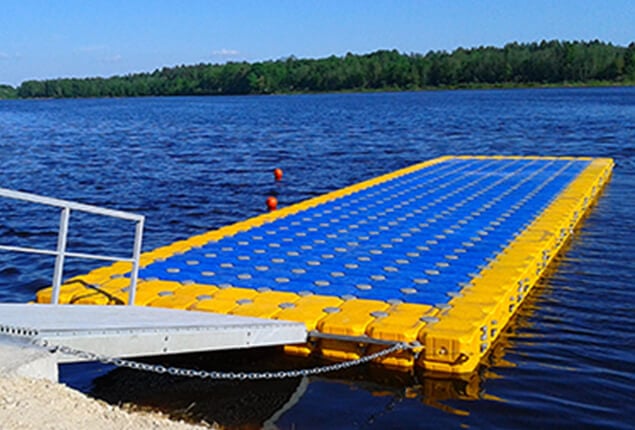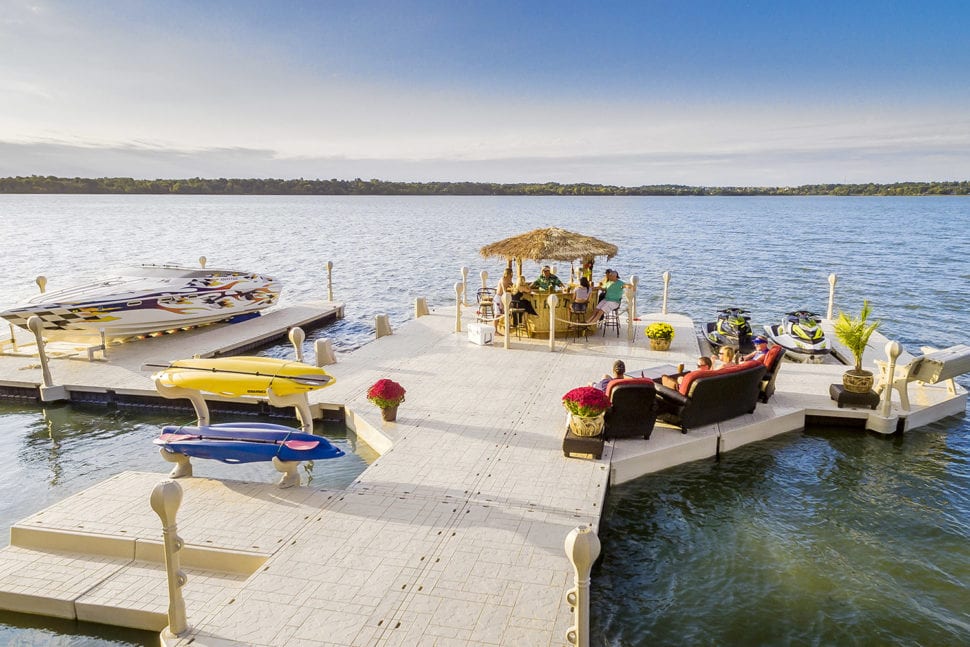Create the Perfect Docking Solution With Floating Docks
Floating docks existing a flexible service for a variety of maritime requirements, adjusting effortlessly to fluctuating water degrees and varied vessel types. As we explore the important aspects that contribute to the performance of floating docks, numerous key variables regarding security and maintenance will certainly arise, raising questions regarding how to maximize your docking experience.

Advantages of Floating Docks
Floating docks deal many advantages that make them an excellent choice for numerous maritime applications. One of the key benefits is their versatility to changing water levels. Unlike fixed docks, floating docks fluctuate with the tide, guaranteeing constant access for vessels. This attribute is specifically essential in areas susceptible to substantial tidal fluctuations or seasonal water level changes.
In addition, floating docks are normally much easier and quicker to set up compared to conventional set frameworks. Their modular style enables for uncomplicated assembly and disassembly, facilitating upkeep and relocation when required. This flexibility is especially useful for momentary applications or in environments where conditions might transform.
Floating docks also often tend to be more environmentally pleasant, as they reduce disruption to the seabed and surrounding water environments. Their buoyant nature reduces the risk of damages to marine life, advertising a healthier environment. These docks can be tailored to suit different vessel sizes, making certain that they fulfill certain operational requirements.
Eventually, the combination of versatility, simplicity of installation, and ecological considerations makes floating docks a very efficient solution for a wide array of maritime requirements.
Selecting the Right Products
Selecting the ideal materials for floating docks is critical to guarantee security, resilience, and long life. The selection of products straight impacts the dock's performance in numerous ecological conditions, consisting of direct exposure to water, sunlight, and possible wear from marine website traffic.
Usual materials used for floating docks consist of aluminum, timber, and high-density polyethylene (HDPE) Light weight aluminum is light-weight, corrosion-resistant, and needs marginal maintenance, making it an outstanding selection for longevity. Its first price can be greater contrasted to various other materials.
Timber, while visually attractive and supplying a standard appearance, can be vulnerable to rot and bug damages otherwise appropriately treated. Using pressure-treated wood or normally durable varieties like cedar or redwood can minimize these problems.
HDPE is a prominent option as a result of its resistance to UV rays and chemicals, in addition to being environmentally friendly. dock company. It is lightweight and offered in different shades, enabling modification
Ultimately, the best material choice will certainly rely on specific demands, consisting of budget plan, preferred aesthetics, and ecological considerations. Careful assessment of these variables will bring about a effective and resistant floating dock remedy.
Layout Considerations for Security
When creating floating docks, making sure security is an essential element that can substantially influence their performance and safety. Stability in floating dock style is affected by various elements, including buoyancy, weight distribution, and the plan of parts. An optimum buoyancy system should use products that provide sufficient lift while minimizing weight. This equilibrium makes sure that the dock stays above water, also under varying loads.
Weight distribution is important; evenly dispersing loads across the dock stops turning and improves stability. This can be accomplished via strategic positioning of docking devices, such as fenders and cleats, as well as proper spacing of drifts. In addition, the measurements of the dock must be thoughtfully prepared. Larger layouts can use increased stability, particularly in rough water problems, while longer docks might call for added assistances to avoid drooping.
One more vital consideration is the ecological influence, including wave activity and wind. Integrating attributes such as sidewalls or skirting can help mitigate the results of environmental pressures, preserving stability in unfavorable problems. Inevitably, a combination of thoughtful layout, product option, and understanding of ecological variables will certainly yield a floating dock that meets both security and safety and security needs.
Installment Tips and Strategies

Next, secure the essential authorizations and stick to regional guidelines, which might determine setup techniques and environmental factors to consider. If called for, engage a qualified service provider experienced in floating dock setups. Use top notch products developed for aquatic environments to enhance sturdiness and long life.
When placing the dock, straighten it identical to the shoreline to promote easy access. Ensure that the anchoring system is robust, utilizing concrete blocks or helical supports to stabilize the dock against wind and wave activity. It's vital to represent seasonal water degree fluctuations, consisting of possible ice activity in chillier climates.
Throughout the installment, confirm the dock's floatation and security before finalizing the anchoring. Regularly evaluate the setup for any indicators of wear or damages. By complying with these ideas and techniques, you can attain a safe and secure, functional, and visually pleasing floating dock installment that meets your requirements.
Upkeep and Care Guidelines
Keeping and caring for floating docks is important to lengthening their life-span and ensuring risk-free usage. Regular assessments need to be carried out to identify any type of indications of wear, damages, or marine development. Search for cracks, loose fittings, or tarnished areas on the dock's surface, as these concerns can endanger architectural honesty.
Cleaning is vital. Use a pressure washer to get rid of algae, barnacles, and particles, which can gather in time. For persistent development, consider ecologically pleasant cleaner that will not hurt aquatic life.
In addition, examine the mooring lines and supports regularly to guarantee they are protected and free from corrosion. Replace any frayed or harmed lines immediately to maintain security.
Throughout severe weather condition, such as tornados or freezing problems, take precautionary steps. Protect the dock with additional mooring lines and, if viable, eliminate any kind of removable parts to stop damages.
Verdict
To conclude, the application of floating docks presents a functional and efficient docking option appropriate for different maritime applications. Their versatility to varying water degrees, integrated with a modular style, permits very easy modification and moving. Picking ideal materials enhances both longevity and visual appeal, while cautious consideration of security makes sure safety and security and long life. With correct installment and normal maintenance, floating docks can provide dependable and efficient docking experiences for a broad array of vessels.
As we discover the important components that add to the performance of floating docks, several essential factors pertaining to security and maintenance will emerge, elevating inquiries regarding exactly how to read this post here enhance your docking experience. Unlike dealt with docks, floating docks rise and fall with the tide, making sure constant accessibility for vessels.When making floating docks, ensuring stability is a basic facet that can considerably impact their capability and security. Security in floating dock layout is influenced by different factors, including buoyancy, weight distribution, and the setup of elements. Ultimately, try this a combination of thoughtful design, material choice, and understanding of ecological factors will certainly generate a drifting dock that meets both security and safety demands.